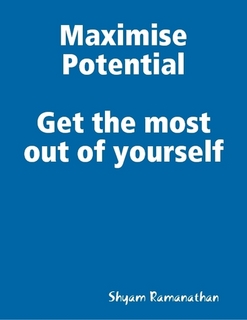7 Principles to Disrupt yourself
Disrupt yourself is a philosophy based on the classic process outlined in the book the Innovators dilemma by Clayton Christensen. Usually it is the disruptors on the low end of the market who disrupt and push the market leaders out. For example Toyota came in with a new model in the 1950’s and the other automakers did not pay attention. We all know the rest of the story.
This whole model is based on the S Curve where there is a long time initially where nothing seems to happen and then at the inflection point growth is exponential before it again becomes stagnant. The best example is Facebook which from its inception took 4 years to reach 10 percent penetration but then it exploded. Even the iPod took more than 3 years to really take off so we have to be patient in anything and everything we try. I like the book Disrupt yourself by Whitney Johnson. Here are the major principles outlined.
Take the right risks– This principle is based on the outcome driven innovation process. For example one of the questions that can be asked is what customer needs to be solved? Take the time to figure out why you are making a move when you disrupt. The author says whenever a merger is done the questions people ask are 1. Do I have my job? 2. How will I get paid? 3. Whom do I report to? Usually people prefer known risks vs ambiguity. Whitney Johnson walked away from a high flying job at Wall Street because she realized the emotional cost of staying was too high and chose to disrupt her career. Nature rewards risk takers. There are two types of people one is Promotion focused – these are people who take chances, maximize their skills, are very creative and there are people who are Prevention focused – they are risk averse and happy with status quo. The people who belong to the latter category should focus on what will be lost if no action is taken or how much money they are leaving in the table by not taking action. What will you miss out on? There are two types of risk 1. Competitive risk – This is whether you can compete and win and 2. Market Risk – This is when you have no idea if there is a customer for this market. We prefer competitive risk which is the norm of business. Firms which created new markets made more money according to the Innovators dilemma. One of the examples was the disk drive industry and what they found from the research at that time was when firms took market risks there was a better chance of success by six times and a revenue growth difference of 20 times than the firms who just took competitive risks. Also be wary of companies flying under the radar for example Blockbuster ignored Netflix and the rest is history (Blockbuster was Netflixed). When you compete your mind is saying you are going into battle because of which cortisol is released and cognitive functions deteriorate. However market risks are a much better bet resulting in a steadier mental health state. The author says identify a job no one else will do meaning specialize in your niche and make sure no one else can do it better than you. Trying something new is less risky.
Play to your distinctive strengths– Here the author suggests that you should match unmet needs with your strengths. Identify what you do well and go through the questions like 1. What skills have helped you survive? 2. What makes you feel strong? 3. What exasperates you about others? 4. Where does your genius emerge? 4. What makes you unique? What compliments do you shrug off? Keep an eye out for compliments you miss out or take for granted. The compliments might show an area of strength that you are ignoring. In every work of genius we recognize our rejected thoughts. 6. What are your hard won skills? These are the skills you have developed through tenacity and determination. These might have taken you a long time to develop. These are skills you learnt after jumping a lot of hurdles.7. Identify your distinctive strengths. Look for ways to combine your passions. Before taking a job make sure you have the strengths to do the job. I think this is important. For example I can start training for tennis now but even if put 10000 hours I am never going to reach world class or even the professional circuit. So match your passion with your strengths. Focus on what you can do that others cannot do as well as you. Tools like Strengths Finder 2.0 are great in identifying your unique talents.
Embrace constraints -Nobody likes constraints. They are unavoidable. Constraints lead to faster feedback. Complete freedom leads to too many complexities. For example all sports coaches have tighter feedback loops for their players. The author says clear thinking coupled with constraints can lead to unequivocal answers. Some of the constraints mentioned are
- Money – Lack of money makes us impatient.
- Knowledge – Lack of it can be a problem. But sometimes not knowing the industry may also lift your blinders and help you see possibilities that others don’t.
- Time – For example the author wanted to write one blog per day but she didn’t have the time. So she asked her readers to write guest blogs. This led to her to write her first book Dare, Dream do.
Battle entitlement – Innovation killer – As per Peter Drucker we should move from talking about achievement and move towards contribution which results in greater success. Entitlement is a risk we all face. Cultural entitlement is where we refuse to look at the other cultures and we see the world with only a single myopic lens. The antidote is to transport yourself to new cultures and open up your network exposing yourself to new ideas. As Peter Theil noted in his wonderful book Zero to One when we create something new we come from 0 to n. Emotional entitlement is when we believe we are owed something by life. The antidote is to be grateful ad keep saying thank you. Intellectual entitlement is when we refuse to listen to others who have something to say. The antidote is to not shoot the messenger and appreciate everyone’s input irrespective of their pecking order in the hierarchy.
Benefits of stepping back. Step back may mean changing what you are doing currently. It could be similar to a concept called zero based thinking where you say knowing what I now know will I be doing this activity. For example if you reached the top of the ladder you then need to find a new ladder. When you step back you can clearly define what success means to you. Based on what metrics do you measure your life? The author also encourages showing up and keeping showing up for everything you do in life. Another question you can as is “What can I do to make my life really count?” Once you find your life purpose each day becomes an exciting journey.
Give failure its due– As Henry Ford said failure is only an opportunity to intelligently begin again. There is a well-known experiment conducted by Carol Dweck on a group of students. Half the students were praised for performance, and another half were praised for effort for solving an easy puzzle. Then a very tough puzzle was given to the same groups which could not be solved. The ones who were praised for performance gave up this time and they said that they don’t have the ability to solve it. However the folks in the second group who were praised for effort were found to persist longer and were confident that by increasing their learning capacity they can solve the puzzle. This is called the growth mindset. You need to be prepared to fail and have a support structure in place when you fail. The author also encourages acknowledging and sharing sadness. It is important to grieve. On the subject of vulnerability be sure to read Daring Greatly and Rising Strong by Brene Brown who is an expert on vulnerability. Don’t hide your failure and it is better to share it with those you trust. You can also ask “What I have learned that I didn’t know before the failure?” As per Seth Godin in his bestselling book Dip winners quit all the time and they just quit the right activities. If you are pursuing a goal that is not working out it creates discontent so quit when you need to and there is no hope of progress. Of course we know the famous failure of J.K. Rowling whose marriage failed, who was jobless, had clinical depression and she even thought of committing suicide but she came back brilliantly. This serves as a lesson for all of us to never give up. She said “Rock bottom became the solid foundation on which I rebuilt my life.”
Be Driven to Discovery - As trail blazer flexibility is important. Picture yourself as an explorer completely venturing into unknown territory where little is known and much is assumed. Here are the steps for the discovery driven process.
- Create a Reverse Income statement – First decide the income you want to achieve and then decide how much revenue you need to meet that income. For your career it may mean deciding first to earn 100k and then reverse engineering on how to achieve that.
- Calculate the cost – Decide what kind of money, time and expertise you are willing to invest to get to your goal.
- Compile an assumption checklist - List out all the assumptions you have.
- Prepare a milestone chart - For example if you want to become a doctor be clear on what grades you need to get into school, and alter your course when there is new information or constraints that blocks your progress.
Finally it has been found that the qualities required to get into the C-Suite of an organization are an insatiable curiosity and a strong willingness to learn. The author says a discovery driven career is lonely but the outcome is worth the effort.
Disrupting yourself on a regular basis can lead you to a richer and more rewarding life. It was a nice read and worth the time invested.
The views expressed in this article are
my own and does not represent my organization.
The print version of my book
Maximise Potential which has everything I have learnt on leadership,
management, success, personal development and a few book reviews
is available in Amazon Maximise
Potential
My eBook Maximise Potential is
available in Amazon Maximise
Potential eBook









Comments
Post a Comment